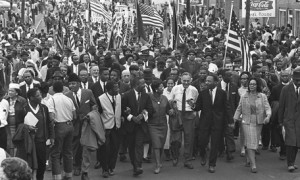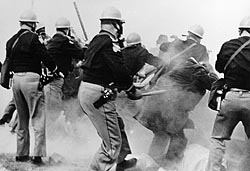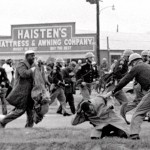“Don’t worry about it.”
Those familiar with the early morning events of December 7, 1941, are familiar with this regrettable phrase. When Lieutenant Kermit Tyler dismissed an inexperienced radar operator’s vague report of unidentified aircraft approaching Hawaii on that morning, the response was not unreasonable. However, the failure to consider the overall possibilities of that warning resulted in the catastrophe of Pearl Harbor. Today, many journalists and ordinary citizens are taking a similar approach to Lt. Tyler of the Supreme Court reviewing a key provision to the 1965 Voting Rights Act.
Shelby v. Holder
 Before this session of the Supreme Court is Shelby County, Alabama v. Holder. The constitutional issue before the justices is whether or not the formula used to determine evidence of election discrimination still justifies the measures outlined in Section 5 of the act.
Before this session of the Supreme Court is Shelby County, Alabama v. Holder. The constitutional issue before the justices is whether or not the formula used to determine evidence of election discrimination still justifies the measures outlined in Section 5 of the act.
At the heart of Section 5 is the requirement of specific political subdivisions – including entire states – to receive federal permission before making changes to voting and registration procedures. These jurisdictions are identified by the use of the formula whose data dates back to 1972. Shelby County argues the problem Section 5 was intended to remedy – as defined by the data used in the legislation’s formula – no longer reflects contemporary reality. As such, Shelby County, Alabama argues that continued use of Section 5 is a violation of the Tenth Amendment and Article IV of the Constitution.
Again, many political journalists otherwise supportive of the Civil Rights Act’s aims are giving acceptable resignation to this viewpoint. There is, however, no small amount of irony in the contemporary press’s coverage of this matter before the court. Nearly a half-century ago, the press played an indispensable part in forwarding civil rights legislation.
Faded images
 Among the many iconic images in American history are those of three attempted protest marches, two violently suppressed, and one successful, in early March of 1965. Though nearly all White American was aware of the Jim Crow in the officially segregated former Confederacy, moral denial was made possible in part to the pusillanimous aversion by most journalists in covering the reality borne by African-Americans since 1877. While the South was overtly segregated, many of the remaining states operated to varying degrees with informal segregation. This hypocrisy tempered any instincts to criticize the South for its regressive practices. However, widespread ownership by the early 1960s of black and white television sets pulled away from the convenient cloak of denial and apathy.
Among the many iconic images in American history are those of three attempted protest marches, two violently suppressed, and one successful, in early March of 1965. Though nearly all White American was aware of the Jim Crow in the officially segregated former Confederacy, moral denial was made possible in part to the pusillanimous aversion by most journalists in covering the reality borne by African-Americans since 1877. While the South was overtly segregated, many of the remaining states operated to varying degrees with informal segregation. This hypocrisy tempered any instincts to criticize the South for its regressive practices. However, widespread ownership by the early 1960s of black and white television sets pulled away from the convenient cloak of denial and apathy.
Many Americans are familiar with the association of Dr. Martin Luther King, Jr. and the march from Selma, Alabama to the state capital in Birmingham. It is doubtful that many know that the more famous demonstration, the 60 mile trek to the capital, was preceded by two other events. The first of these abortive attempts became known as Bloody Sunday when Alabama State Police bludgeoned and tear-gassed the original 600 or so marchers on March 7. The assembly intended to further register blacks and to protest the recent murder by an Alabama State Police officer of Jimmy Lee Johnson, who died unarmed while protecting his mother from police clubbing.
 The national press was on hand to cover the story. In tens of thousands of homes across the nation, the evening network news that accompanied the family dinner came with scenes of animal savagery on the part of the authorities. King appealed for the clergy of all denominations and color to come to Alabama that Tuesday.
The national press was on hand to cover the story. In tens of thousands of homes across the nation, the evening network news that accompanied the family dinner came with scenes of animal savagery on the part of the authorities. King appealed for the clergy of all denominations and color to come to Alabama that Tuesday.
Come they did – 2,500 of them – far exceeding the expectations of the organizers.
Designated Turn-around Tuesday, the second demonstration was intended to be entirely ceremonial. The organizers had petitioned a federal district court for an injunction against further disruption from the police. The judge ordered a restraining order against the intended march until he could consider the petition for an injunction. King and others did not want to violate the order of a judge thought to be sympathetic to the marchers. Turn around Tuesday’s only goal was to assemble and march across the Edmund Pettus Bridge, hold a prayers session and then return back across the bridge.
Few anticipated that King’s plea for support by clergy and others would be so well heeded. Over four times the number of participants of Bloody Sunday had arrived that Tuesday. Not all of them were aware of the goal to cross the bridge, pray and then return. For one of these, it would be a fatal miscommunication.
Reverend James Reeb was far from being the only white member of the clergy to travel a good distance in response to Dr. King’s appeal made on Bloody Sunday. The Boston pastor’s unfortunate distinction was, however, his being murdered. Reeb, who had mistakenly prepared to march to Montgomery, remained in Selma the night of the turnaround. He was among several white pastors beaten by segregationists. He died two days later. Extensive coverage of Reeb’s death caused a spike in national outrage against segregation violence. That Jimmy Lee Johnson’s murder two weeks earlier caused no similar stirrings of passionate indignation from the press was not lost on African-Americans.
During the previous year, following the passage of the 1964 Civil Rights Act, President Lyndon B. Johnson instructed Attorney General Nicholas Katzenbach “to write me the goddamn best, toughest voting rights act that you can devise.” On the Monday following Reverend Reeb’s death, that act was presented to Congress. It was the third such voting rights bill since 1957.
Voting Rights Acts past, present, and future
What was remarkable about the 1965 Voting Rights Act was its preventive enforcement provision, Section 5. Two previous federal acts had sought to end suppression of African-American voter registration and actual voting. In each instance, segregated states enacted laws and regulations that had the effect of disenfranchising blacks. Some were more insidious than others. When stilted laws didn’t work, overt denial of registration, official disinformation of polling locations or times were employed. Further barriers to voting included outright physical and economic intimidation.
In 1964, the 24th Amendment to the Constitution ended one of the longest-lived means of discouraging or denying the franchise to African-Americans and poor whites. Since the end of Reconstruction, nearly a dozen states in the South enacted a poll tax with the intended effect of winnowing down those few blacks who might have somehow been “allowed” to register. By the time the Amendment was finally passed, only five states still maintained a poll tax. This was not a sign of progress, however; other methods of suppression worked just as well.
Following each of the first two Voting Rights Acts, one passed in 1957 and the second three years later in 1960, Southern states enacted or expanded discriminatory laws that effectively negated any potential advancement of minority voting rights. Literacy tests, character standards and other arbitrary barriers to voting joined such post-Reconstruction schemes as the Grandfather Clause to circumvent not only the recent voting rights acts, but the 15th Amendment. There was, however, recourse against such barriers.
Under both voting rights bills preceding the ’65 act, litigation by the justice department was a remedy. The burden of proof was upon the alleged disenfranchised voter. For all intents and purposes, it was a case of closing the barn door after the horse had fled. The legislation sent to Congress by the Johnson Administration was remarkably different.
Preclearance prevents voting rights violations
Addressing the pattern by voting jurisdictions, including entire states, the ’65 Voting Rights Act sought to prevent – not remediate – voter suppression. Using the enforcement powers granted Congress by the 14th and 15th Amendments, the new legislation provided a formula for identifying political subdivisions with a history of voting discrimination. Those states and districts with such histories were required to receive federal preclearance before making any changes to registration, polling locations and times as well as voting requirements.
Once enacted, the Voting Rights Act with its new preventive mechanism had the almost immediate effect of reversing nearly a century of minority disenfranchisement. The success in dramatically reducing voter discrimination can be squarely credited to Section 5 of the Act, the provision now being considered by the Roberts Court.
Perhaps the history that drove the inclusion of Section 5 into the Voting Rights Act has been forgotten by many journalists. Also likely is the belief that such progress has been made in the South that this provision is an anachronism and therefore no longer justified by the 14th and 15th Amendments. Regardless, without the primary enforcement provision of the law, litigation, once again, becomes the remedy for a citizen alleging a barrier to his or her right to vote.
Congress, with bipartisan support and executive approval from both major parties, has renewed the Voting Rights Act several times since 1965. The law has been amended to expand the coverage not only to African-Americans but to other racial minorities. Provisions to include ballots in other languages besides English have been added to reflect the growing diversity of citizens. Other developments to the law include the amended ability for political subdivisions demonstrating a continued record of lawful voting practices to “bailout” of the preclearance requirement and many voting jurisdictions have successfully received removal from Section 5’s requirements. The formula, however, contains data over three decades old, raising the legitimate question of the continued need for that provision.
Worry about it
The Supreme Court’s conservative bloc has signaled its willingness to accept the proposition that, as Chief Justice John Roberts stated, “Things have changed in the South.” As noted, many journalists are likewise disposed to accept that Section 5 is now an unwarranted and unconstitutional feature violating the 10th Amendment. What hasn’t changed, arguably, is the continued effort to discourage or prevent minority voting through less-than-scrupulous legislation with the effect of suppressing voting among minority populations.
There may be valid evidence that Section 5’s guiding formula no longer reflects present-day reality and so it is highly likely that a 5-4 decision by the Supreme Court will strike down that section. Journalists are correct in predicting this possible outcome. However, such prognostications that don’t take into account the circumstances that necessitated Section 5 as a departure from litigation-only provisions of past voting legislation is irresponsible.
Voter ID laws and last-minute changes to polling locations and early voting opportunities must at least be considered first cousins to literacy tests and poll taxes. Evidence of voter fraud is significantly scarcer than evidence indicting the formula used in Section 5. For the national media to ignore this dilemma of returning to litigation known to be easily evaded by local politics is to return to a press that ignored segregation for generations before the civil rights movement.
